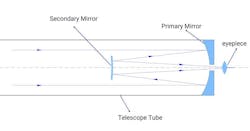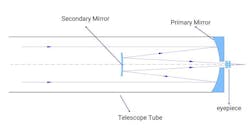Ritchey-Chretien Telescopes
The Ritchey-Chrétien (RC) telescope, a type of reflecting telescope falling under the Cassegrain optical system, was designed by George Ritchey and Henri Chrétien in 1910. The name “RC Telescope” is derived from the initials of these two inventors. One of the key advantages of reflecting telescopes like the RC telescope is that they don’t suffer from chromatic aberration, unlike refracting telescopes. Reflecting telescopes typically have a metal coating, allowing them to operate across a wide range of wavelengths, including both visible and infrared bands. This versatility is one reason why many astronomical telescopes opt for a reflective design.
Reflecting Telescope
The first reflective telescope, invented by Newton, utilized a spherical mirror. However, spherical mirrors are known to suffer from spherical aberration, which is directly proportional to the cube of the aperture size. This limits the F-number and the quality of the image. Despite this, spherical mirrors have their advantages. They possess numerous axes of rotational symmetry, resulting in a more uniform image quality across the field of view. This makes them suitable for systems with a small relative aperture and lower image quality requirements. However, as demonstrated by the spot pattern of a Newton telescope with an F=8.3, the image quality across the entire field of view is less than ideal due to spherical aberration.
Cassegrain System & RC Telescope
Reflective telescopes, while advantageous in many ways, do face the issue of spherical aberration. To address this, optical designers have developed various methods and created different variants of the telescope. One classic design involves the addition of a convex mirror to the structure. This not only reduces the overall length of the telescope but also enhances the image quality due to the added flexibility provided by the convex mirror. This design is known as the Cassegrain system.
In a Cassegrain system, there are two mirrors: the concave mirror (or primary mirror) and the convex mirror (or secondary mirror). The introduction of the secondary mirror results in a portion of the light being blocked. The ratio of the diameter of the blocked light to the diameter of the input beam is referred to as the light block coefficient. A system with a large light block will suffer from significant energy loss and a decrease in image quality. Therefore, it’s crucial to choose an appropriate blocking ratio during the design process.
The classical Cassegrain telescope typically employs a paraboloid as the main mirror. The paraboloid ensures an equal optical path, effectively resolving the issue of spherical aberration. However, a paraboloid has only one axis of rotational symmetry. If the beam of light doesn’t hit it perpendicularly, it can lead to an increase in coma with the widening of the field of view. There’s also a certain degree of astigmatism and field curvature. As a result, while the axial image quality of this telescope is excellent, the off-axis image quality is less than ideal, limiting the available field of view. For instance, an F=8.3 Cassegrain telescope, despite achieving the diffraction limit in the axial field of view, exhibits noticeable coma in the off-axis field of view.
RC Telescope Advancements
Based on the Cassegrain system, the RC telescope was developed using hyperboloids for both the primary and secondary mirrors. The RC telescope effectively eliminates most spherical aberrations and comas. Although the on-axis image mass decreases slightly compared to parabolic reflection systems, this decrease is not significant. Since the coma is eliminated, the off-axis image quality of the RC telescope is improved, resulting in more uniform image quality.
However, the RC telescope has not completely resolved the issues of field curvature and astigmatism. The light spot generally expands elliptically after the field of view increases. To address this, field lenses can be added in front of the image field of the RC telescope to correct aberrations, further improving image quality.
RC Telescope Summary
RC telescopes are reflector telescopes with hyperboloids for both primary and secondary mirrors. Compared to other forms of Cassegrain systems, RC telescopes can have a larger relative aperture, typically between F6 and F10. The image quality on the axis can easily reach the diffraction limit, and in a certain field of view, the off-axis image quality can also be maintained well. The image quality of a larger field of view can be further improved with compensation lenses.
However, RC telescopes have some drawbacks. Due to the telescope’s structure, there is a blackout, resulting in energy loss. Additionally, the structure is prone to introducing large aberrations due to eccentricity, requiring precise alignment and maintenance. Moreover, the hyperbolic mirrors are relatively difficult to process and more expensive than spherical or other forms of reflectors.
Despite these challenges, the RC telescope has played an important role in certain fields, particularly in astronomical observation.
Do not hesitate to contact Shanghai Optics today. We’d be more than happy to discuss your projects and how best they can become a success.



